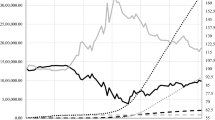Abstract
The growth rate plays an important role in determining a firm’s asset and equity values, nevertheless the basic assumptions of the growth rate estimation model are less well understood. In this paper, we demonstrate that the model makes strong assumptions regarding the financing mix of the firm. In addition, we discuss various methods to estimate firms’ growth rate, including arithmetic average method, geometric average method, compound-sum method, continuous regression method, discrete regression method, and inferred method. We demonstrate that the arithmetic average method is very sensitive to extreme observations, and the regression methods yield similar but somewhat smaller estimates of the growth rate compared to the compound-sum method. Interestingly, the ex-post forecast shows that arithmetic average method (compound-sum method) yields the best (worst) performance with respect to estimating firm’s future dividend growth rate. Firm characteristics, like size, book-to-market ratio, and systematic risk, have significant influence on the forecast errors of dividend and sales growth rate estimation.
Similar content being viewed by others
Notes
For a more detailed survey of the literature, see Brick et al. (2014).
Gordon and Shapiro’s (1956) model assume that dividends were paid continuously and hence \(P_{0} = {{d_{1} } \mathord{\left/ {\vphantom {{d_{1} } {(r - g)}}} \right. \kern-0pt} {(r - g)}}\).
Earnings in this model are defined using the cash-basis of accounting and not on an accrual basis.
The growth rates for Pepsico obtained by continuous and discrete regression methods are not statistically different from zero.
The growth rates for Pepsico obtained by continuous and discrete regression methods are not statistically different from zero.
When applying Gordon’s growth model, internal growth model, and sustainable model, additional information should be obtained, including the required rate of return for equity holders, ROE, ROA, and the retention rate. As defined by Eq. (2), ROE and ROA are obtained from the ratios of net income of the year to the book value of common equity and the book value of total assets at the beginning of year. Retained earnings are computed as one subtract to the ratio of cash dividends to the income before extraordinary items. We apply Gordon’s growth model with cost of equity by CAPM, in that the CAPM-based cost of equity is calculated as individual firm’s beta times market risk premium plus risk-free rate. Individual firm’s beta is estimated over the past three years monthly returns and risk-free rate and market risk premium is retrieved from Kenneth French’s website, http://mba.tuck.dartmouth.edu/pages/faculty/ken.french/data_library.html.
References
Baucus D, Golec J, Cooper J (1993) Estimating risk–return relationships: an analysis of measures. Strateg Manag J 14:387–396
Boudreaux KJ, Long RW (1979) The weighted average cost of capital as a cutoff rate: a further analysis. Financ Manag 8:7–14
Brick IE, Weaver DG (1984) A comparison of capital budgeting techniques in identifying profitable investments. Financ Manag 13:29–39
Brick IE, Weaver DG (1997) Calculating the cost of capital of an unlevered firm for use in project evaluation. Rev Quant Financ Account 9:111–129
Brick IE, Palmon O, Venezia I (2012) The risk–return (Bowman) paradox and accounting measurements. In: Venezia I, Wiener Z (eds) Bridging the GAAP: recent advances in finance and accounting. World Scientific Publishing Company, London
Brick IE, Chen H, Lee CF (2014) Alternative methods for estimating firm’s growth rate. In: Lee CF, Lee A (eds) Encyclopedia in finance, 2nd edn, Chap. 64, 755–764
Chambers DR, Harris RS, Pringle JJ (1982) Treatment of financing mix in analyzing investment opportunities. Financ Manag 11:24–41
Chen HY, Gupta MC, Lee AC, Lee CF (2013) Sustainable growth rate, optimal growth rate, and optimal payout ratio: a joint optimization approach. J Bank Financ 37:1205–1222
Fama EF, French KR (1992) The cross-section of expected stock returns. J Financ 47:427–465
Gordon J, Gordon M (1997) The finite horizon expected return model. Financ Anal J 53:52–61
Gordon M, Shaprio E (1956) Capital equipment analysis: the required rate of profit. Manag Sci 3:102–110
Higgins RC (1977) How much growth can a firm afford? Financ Manag 6:7–16
Higgins RC (1981) Sustainable growth under inflation. Financ Manag 10:36–40
Higgins RC (2008) Analysis for financial management, 9th edn. McGraw-Hill Inc, New York
Lee AC, Lee JC, Lee CF (2009) Financial analysis, planning and forecasting: theory and application, 2nd edn. World Scientific Publishing Company, Singapore
Lee CF, Gupta MC, Chen HY, Lee AC (2011) Optimal payout ratio under uncertainty and the flexibility hypothesis: theory and empirical evidence. J Corp Financ 17:483–501
Lee CF, Finnerty JE, Lee AC, Lee J, Wort DH (2012) Security analysis, portfolio management, and financial derivatives, 2nd edn. World Scientific Publishing Company, Singapore
Lee CF, Lee JC, Lee AC (2013) Statistics for business and financial economics, 3rd edn. Springer, New York
Ross SA, Westerfield RW, Jaffe J (2012) Corporate finance, 10th edn. McGraw-Hill/Irwin, New York
Author information
Authors and Affiliations
Corresponding author
Rights and permissions
About this article
Cite this article
Brick, I.E., Chen, HY., Hsieh, CH. et al. A comparison of alternative models for estimating firm’s growth rate. Rev Quant Finan Acc 47, 369–393 (2016). https://doi.org/10.1007/s11156-015-0504-6
Published:
Issue Date:
DOI: https://doi.org/10.1007/s11156-015-0504-6
Keywords
- Equity valuation
- Estimation of growth rate
- Gordon’s growth model
- Determinants of growth forecast errors




